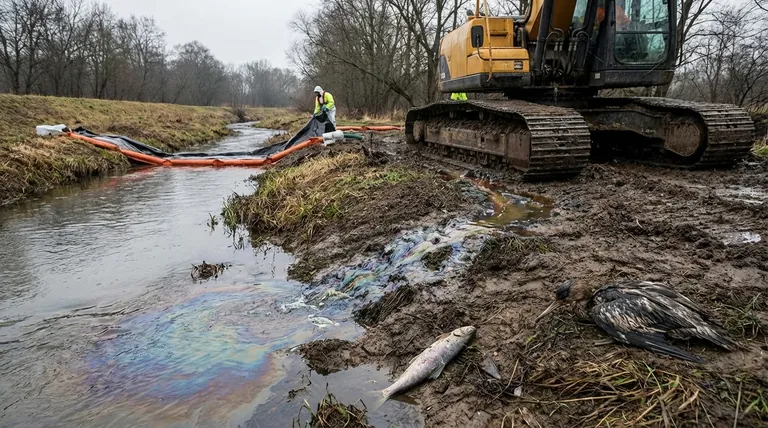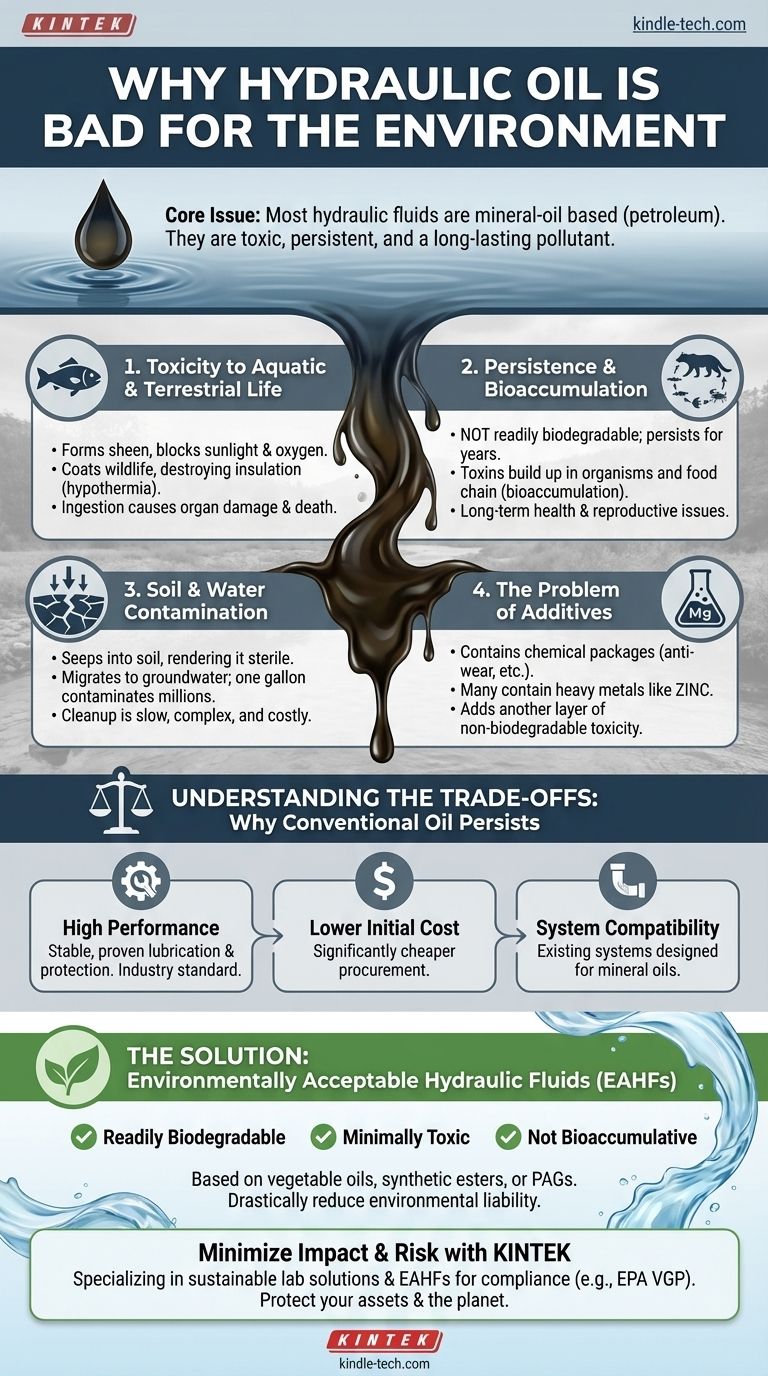The primary reason conventional hydraulic oil is harmful to the environment is its composition. Most hydraulic fluids are mineral-oil based, derived from petroleum. When spilled or leaked, this oil is toxic to wildlife, persists in ecosystems for long periods, and contaminates soil and water, making it a significant and long-lasting pollutant.
The core issue is not just that hydraulic systems leak—they often do—but that the consequences of a spill involving conventional petroleum-based oil are severe. Its toxicity and inability to break down naturally create a long-term environmental liability that is difficult and expensive to remediate.

The Core Environmental Dangers of Mineral-Based Hydraulic Oil
The environmental impact of a hydraulic oil spill can be broken down into several distinct, cascading problems. These issues stem directly from the chemical nature of the petroleum base oil and its additives.
Toxicity to Aquatic and Terrestrial Life
A spill introduces toxic substances directly into an ecosystem. On water, oil forms a sheen that blocks sunlight and oxygen transfer, disrupting the foundation of the aquatic food web.
Direct contact is devastating. Oil coats the feathers of birds and the fur of mammals, destroying their natural insulation and buoyancy, often leading to hypothermia and drowning. If ingested, the oil is a poison that causes severe internal damage to an animal's organs.
Persistence and Bioaccumulation
Unlike naturally occurring fats, mineral-based oil is not readily biodegradable. It does not break down quickly through natural microbial action. This means it can persist in soil or sediment for years, continuing to release toxic compounds.
This leads to bioaccumulation, where the toxic components of the oil build up in organisms. Small creatures ingest contaminated material, and as they are eaten by larger predators, the concentration of toxins increases up the food chain, causing long-term health and reproductive issues for wildlife.
Soil and Water Contamination
When hydraulic oil leaks on land, it seeps into the soil, contaminating it and rendering it sterile and unusable for agriculture. It can poison the root systems of plants and kill essential soil microorganisms.
This contamination can also migrate downward, eventually reaching groundwater. A single gallon of oil can contaminate a million gallons of fresh water, making it a significant threat to drinking water supplies. Cleaning contaminated soil and groundwater is an extremely slow, complex, and costly process.
The Problem of Additives
Hydraulic oil is not just a base oil; it contains a package of chemical additives to enhance performance. These often include anti-wear agents, corrosion inhibitors, and foam suppressants.
Many of these additives contain heavy metals like zinc (from ZDDP, a common anti-wear additive). When spilled, these heavy metals become pollutants in their own right, adding another layer of toxicity to the environment that does not biodegrade.
Understanding the Trade-offs: Why Is Conventional Oil Still Used?
Despite these clear environmental risks, mineral-based hydraulic oils remain the most common choice for a few key reasons. Understanding these trade-offs is essential for making informed decisions.
High Performance and Stability
Conventional mineral oils offer a proven, high-performance solution. They are stable across a wide range of temperatures and pressures, provide excellent lubrication, and protect system components from wear effectively. For decades, they have been the industry standard upon which hydraulic systems were designed.
Lower Initial Cost
From a purely procurement-based perspective, standard mineral oils are significantly cheaper to purchase than environmentally acceptable alternatives. For operators focused solely on minimizing upfront component costs, this remains a powerful incentive.
System Compatibility and Inertia
Hydraulic systems are often designed and tested specifically for use with mineral oils. Switching to an alternative fluid may require a costly system flush and, in some cases, changing seals and hoses that may not be compatible with the new fluid type. This operational friction often leads to sticking with the default choice.
The Rise of Environmentally Acceptable Hydraulic Fluids (EAHFs)
In response to the risks of mineral oils, a new class of fluids has emerged. Environmentally Acceptable Hydraulic Fluids (EAHFs) are designed to minimize environmental damage in the event of a spill.
What Makes a Fluid "Environmentally Acceptable"?
For a fluid to be classified as an EAHF, it must meet specific criteria defined by regulatory bodies like the EPA. The three pillars are:
- Readily Biodegradable: It must break down into harmless substances by natural microbial action within a short period (e.g., >60% in 28 days).
- Minimally Toxic: It must have very low toxicity to fish, invertebrates, and algae.
- Not Bioaccumulative: It must not build up in the tissues of organisms.
Common Types of EAHFs
Most EAHFs are based on vegetable oils (like canola), synthetic esters, or polyalkylene glycols (PAGs). While they can have a higher upfront cost and may require more careful management, they drastically reduce the environmental liability of a spill.
When are EAHFs Required?
Regulations increasingly mandate the use of EAHFs, especially in sensitive areas. The U.S. EPA's Vessel General Permit (VGP), for instance, requires all vessels operating in U.S. waters to use EAHFs in any oil-to-sea interface where a spill is possible. This applies to equipment like stabilizers, rudders, and deck machinery.
Making the Right Choice for Your Application
Choosing a hydraulic fluid requires balancing performance, cost, and environmental risk. Your operational context should guide your decision.
- If your primary focus is standard performance in a controlled environment: Conventional mineral oil remains a viable option, but this choice must be paired with rigorous spill prevention, containment plans, and immediate cleanup protocols.
- If you operate in or near sensitive environments (waterways, forests, nature preserves): EAHFs are the responsible choice and are often legally required. The higher initial cost is an insurance policy against catastrophic environmental damage and massive cleanup fines.
- If your organization prioritizes sustainability and risk reduction: Adopting EAHFs is a clear step toward reducing your environmental footprint, minimizing long-term liability, and aligning with modern corporate responsibility standards.
Understanding the full life-cycle risk of your hydraulic fluid is the first step toward responsible and effective asset management.
Summary Table:
| Environmental Hazard | Key Impact |
|---|---|
| Toxicity | Poisonous to wildlife, causes organ damage and death |
| Persistence | Resists biodegradation, contaminating soil and water for years |
| Bioaccumulation | Toxins build up in the food chain, affecting larger predators |
| Additives | Heavy metals like zinc add further, non-biodegradable pollution |
Minimize your environmental impact and operational risk. KINTEK specializes in providing sustainable laboratory solutions, including environmentally acceptable hydraulic fluids (EAHFs) and spill containment systems. Our experts can help you select the right fluid for your application, ensuring compliance with regulations like the EPA Vessel General Permit. Protect your assets and the planet—contact our team today for a consultation tailored to your lab's needs.
Visual Guide

Related Products
- High-Purity Titanium Foil and Sheet for Industrial Applications
- Molybdenum Disilicide (MoSi2) Thermal Elements Electric Furnace Heating Element
- Hydraulic Diaphragm Lab Filter Press for Laboratory Filtration
People Also Ask
- How can you improve corrosion resistance? Extend Equipment Life with Proven Strategies
- What products are manufactured with titanium? The Ultimate Guide to High-Performance Materials
- Why is platinum unreactive? The Atomic Secrets Behind Its Remarkable Stability
- What are two disadvantages of metal? Understanding Corrosion and Weight Limitations
- What is titanium disadvantages and advantages? Weighing Performance vs. Cost for Your Project


